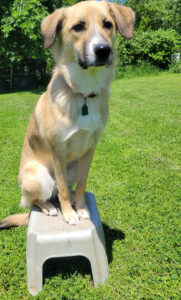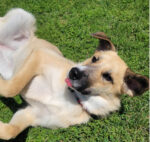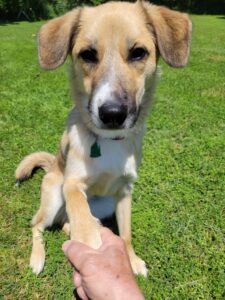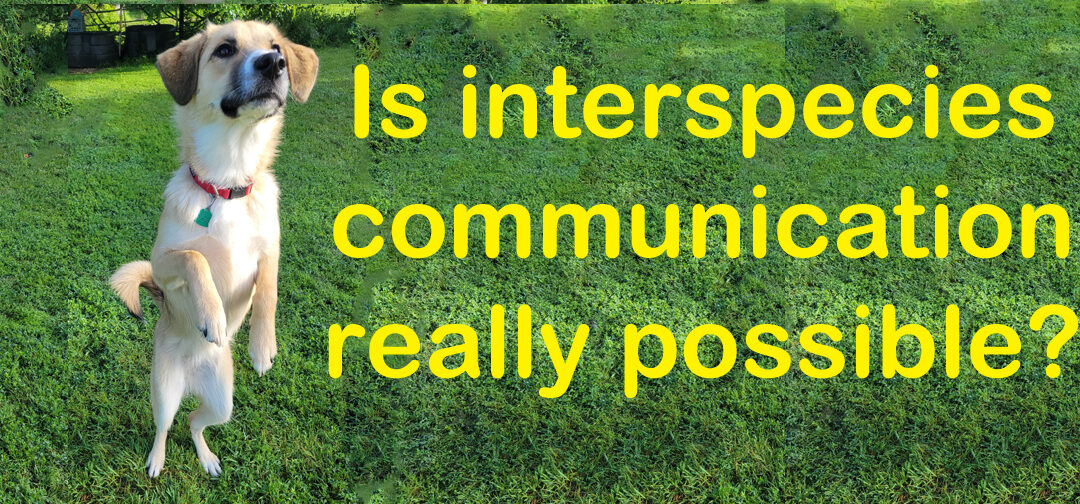I thoroughly enjoyed the first season of Star Trek: Enterprise because they spent much of the time grappling with communication issues. Universal translators, missing databases, peculiar methods of communication, and one memorable episode without a translator. I highlight this because finding similarities is one of my key problem-solving tools. When it comes to training a dog, communication is absolutely everything.
Imagine, a dog has no inherent understanding of human concepts. Yet, with the right incentives, they quickly learn to adapt to our ways. But then, who really is training whom?

Audition tape
Venn came into our lives at about 9 months old. She had already endured the Dallas shelter system twice, and as one of the shelter volunteers observed, this dog was not eager to make friends. Given her wary reaction to new people, describing her as standoffish was an understatement—it was more akin to calling a raging inferno a tiny campfire. She might as well have been auditioning for the lead role in “Cujo 2.”
My initial attempts at training Venn were, frankly, a debacle, probably worse than the utter disaster I made of my three years studying Latin. Yet, Venn was gracious; as long as I had a treat in hand, she seemed willing to overlook my fumbling efforts. I only wish my High School Latin instructor had been that forgiving.
 Let’s establish one clear fact: dogs communicate in a language all their own. It’s a blend of visual cues and vocalizations—tail wagging, play bowing, lip licking, and the myriad variations of barking. These behaviors convey core canine feelings and ideas, and I often wonder if we humans have equivalent expressions. The complexities of canine communication dwarf those encountered with any alien species on Star Trek.
Let’s establish one clear fact: dogs communicate in a language all their own. It’s a blend of visual cues and vocalizations—tail wagging, play bowing, lip licking, and the myriad variations of barking. These behaviors convey core canine feelings and ideas, and I often wonder if we humans have equivalent expressions. The complexities of canine communication dwarf those encountered with any alien species on Star Trek.
Both Venn and I are incredibly lucky to have a canine translator right at home—my wife. To be clear, I’m not comparing her to a dog, but her insights have been invaluable. She’s shown me that no matter how much human intention I read into Venn’s actions, I am usually mistaken.
To truly communicate with Venn, I must delve into how she perceives the world and, even more challenging, how she learns. I’ve devoured numerous books on dog training and observed my wife and her trainer work wonders with Venn.

Expressing her opinion
This isn’t to say I’ve adopted every strategy I’ve come across. In line with my own learning style, I need to experiment and embrace my own errors. I keep what works and discard what doesn’t, always guided by Venn’s immediate feedback. She’s quick to show me what resonates with her, gladly accepting treats even when my words and gestures fall flat.
As a retired engineer, I find the task of bridging communication gaps between species to be a formidable challenge, even more so than debugging communication channels between systems from different companies. And I must confess, the parallels to Star Trek add a delightful zest to my efforts.
The true reward, however, is witnessing Venn’s transformation from a dog driven by fear to one who is a thoughtful and engaged companion.

Oliver
Everything here is recounted from my perspective, but Venn is doing her part too. She’s striving to train and understand me. When I’ve been idle at the computer for too long, she communicates clearly—starting with an intent stare and escalating to a sharp bark if I ignore her. She’s attuned to my moods and can sense when I’m feeling overwhelmed or downhearted. Honestly, she might have picked up some of these cues from Oliver, our Australian Shepherd and her best friend, who’s remarkably perceptive.
And not all her actions are motivated by food or play. Although still a young pup, Venn exhibits a robust sense of how things ought to be. By seven PM, she insists I be in the bedroom to join the family for TV time, barking until I comply. Once I’m settled, she contentedly gnaws on her bone or frolics with her favorite toy. Her demands are not about treats or cuddles; they reflect her vision of a proper family evening.
She loves to chew on her toys while perched on the edge of the bed, which often results in toys falling to the floor. I once made the error of picking them up for her. Like any skilled trainer, once she sees a behavior that she approves of, she reinforces it, ensuring I understand my role. Deliberately, she’ll let a toy drop and then fix me with a look that clearly says it’s my turn to act. My wife thinks Venn is doing an excellent job at training me.

Agreement
Engineers are naturally driven to solve problems; it’s our passion. Venn’s lineage stretches back thousands of years, to ancestors who thrived on collaboration with humans, a trait critical for their survival. Together, Venn and I are determined to master this art of communication.
So, what did you say to your dog this morning?
© 2024, Byron Seastrunk. All rights reserved.











I gradually picked up clues on my dogs communication to me about what she wants. Basically she was training me. She always wants my attention when I’m doing something that requires my attention.
Over the years I’ve learned about pack animals and their behaviors but there’s so much more to learn.
LOL! Hmmm – you may be right!! I will have to try English!! Or a Vulcan Mind Meld!
“Legi tuum blogum duobus canibus meis gemellis valde indulgentibus, interrogans eos cur eandem intelligentiae mensuram quam canes tui demonstrant non ostenderent. Responsio eorum erat ut cibum petere coeperint. Forsitan in re disciplinae erravi!”
Thanks to Google Translate, “I read your blog to my two very indulgent twin dogs, asking them why they don’t show the same level of intelligence that your dogs show. Their response was to start begging for food. Maybe I was wrong about training!”
They may not understand Latin.